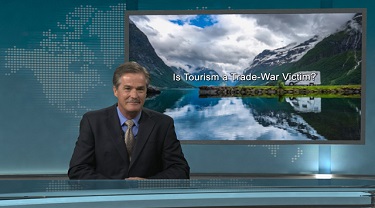Summer in the Northern Hemisphere is break time for most. Sadly, trade-bashers are taking no vacation. Concern is as high as ever about the future state of trade and the direction current rhetoric – and policy – may take. It’s the kind of situation that could really wreck a good vacation, or at worst, lead holiday-makers to cancel plans altogether. Is tourism a trade-war victim?
It may still be too early to tell. Official data on Canada-US travel only extend to May, covering months that are typically tourist- light. Over that period, US visitors to Canada were down 0.9 per cent as compared to the same timeframe in 2017. You might think that a deeply-discounted dollar – ours, that is – would be more of an enticement.
Canadians are travelling South!
What about the flipside? Are Canadians going stateside? You bet – and in spite of a pricey greenback. Through May, Canucks headed south were up 11.5 per cent. Most of these trips are by car, and the bulk of those are same-day trips. Net of quick-in-and-out business travellers, there seem to be a lot of active cross-border shoppers. Go figure.
Shouldn’t we just wait for the real travel season numbers? Well, unlike the past, we actually now have a sense of what’s going on through July. Thanks to automated systems at land crossing points, we now have real-time data on US-licensed vehicles entering Canada and Canadian vehicles re-entering from the US. Given that this is the bulk of total travel, it’s a good proxy for overall activity. What are the numbers saying?
For July, year-to-year US travellers bound for Canada were down by 0.8 per cent – in line with the official data. Big declines were registered for US trips to Quebec (-4.5 per cent) and British Columbia (-3.2 per cent). The latter decline is likely in part due to the BC wildfires and visuals of poor air quality conditions.
Travel numbers are also up in high season
Canadians seem to have edged back on their travel to the US. Compared to the earlier-year numbers, year-to-year figures were not as robust – although they were still up 0.6 per cent over last year. Yes, even in peak season, more trips are being taken stateside in spite of politics and the currency.
What seems to be in the works is sort of the same as for the rest of trade: Canadians are carrying on, with minimal impacts on real activity. Looking at other economic drivers of travel, it does make some sense. Income is a key factor, and in both the Canadian and US economies, job creation together with wage growth is strong, and travellers seem to believe they can afford it. On the trade side, hot US growth is powering cross-border shipments, tariffs, retaliations and renegotiations notwithstanding.
Eye of the storm, or just good weather?
On both counts, there are in very general terms two plausible scenarios: either we are in the eye of the storm, facing impending hurricane-force winds and their devastating impact; or we are operating in two quite separate dimensions: the first, the real economy, with its day-to-day pragmatic movements of goods and services and the second, trade-bluster that is being used to take us to what is hopefully a higher economic plane.
If these are indeed separate dimensions, then the real danger we face is that at some point they would conjoin, or perhaps more appropriately, collide. If rhetoric turns into reality, it would quickly wreck the prosperity we now enjoy. If on the other hand they remain separate, that is, there is some method to the madness that in fact sweeps out remaining protectionist cobwebs in the system, crafting a refined reality, we can welcome an extension of today’s improving times.
For the moment, travellers agree – whether tourists, or those who are travelling the roadways of global business flows. To date, their fears have not kept them from carrying out today’s plans. What is less certain are longer-term projects. Further out, things are less certain, and from what we can tell, people and organizations are less inclined to put their money down on large-scale activities ahead of time.
The bottom line?
Political rancour hasn’t kept tourists from heavy usage of the Canada-US border. Same goes for exporters. Long may that be the case.





